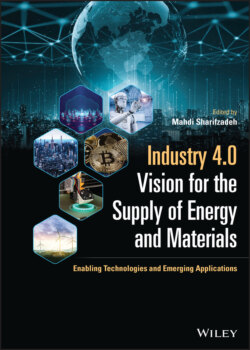Читать книгу Industry 4.0 Vision for the Supply of Energy and Materials - Группа авторов - Страница 15
1.1.3 Key Features of Industry 4.0
ОглавлениеThe innovative aspects of Industry 4.0 are expected to affect various industries such as manufacturing, operation companies, and service providers, yet there is no concise knowledge about challenges in its implementation and its implications and consequences. To better achieve this concept, its main features first must be understood. Based on the literature review, the main features of Industry 4.0 could be identified as:
Smart Environment: The central aspect of Industry 4.0 adopts the expansion of intelligent ecosystems that lead to smart products, smart machines, and augmented operators [14]. In this context, smart machines promote independent and self-optimized processes that imply self-organizing production systems. Typically, smart products are self-aware and communicate individually with systems entities [11]. In response to the increasing variegated systems and their distinct requirements, the concept of augmented operators is introduced in Industry 4.0 as Operator 4.0 [17]. This advanced technology evolves the industrial workforce and creates new forms of cooperation among machines, agents, humans, and robots. These radical changes enable smart environments to automatically identify risks or exceptions and continuously require targets to adjust supply chain parameters.
Integration in Supply Chain: A major characteristic of Industry 4.0 is integration that allows accelerated and flexible responses to systems changes. The integration is achieved at different levels of a system and through CPSs to provide system transparency in the value chain. Basically, there are three dimensions of integration, namely, horizontal, vertical, and end-to-end (E2E). Horizontal integration involves the value chain, such as resources, processes, and information flows within a company and among other enterprises [18]; in contrast, vertical integration concerns incorporating various technologies at different hierarchical levels of a company (e.g., from the equipment to the enterprise planning level; Figure 1.1). In fact, vertical integration allows autonomous CPSs to exchange information and trigger actions to build flexible and reconfigurable factories [19]. E2E integration refers to a holistic life cycle management that aims to facilitate true mass customization with lower operational costs and close the gap across the entire value chain (e.g., between product design, development, and customers).
Efficient Supply Chain: Cooperation of diverse technologies with smart equipment and autonomous robots enhance efficiency in Industry 4.0. Given that an individual technology would have a limited impact on the supply chain, the collaboration of these digital technologies in industrial applications brings new possibilities and adds more values. To achieve this vision, visual computing technologies play an important role as facilitator and provide cohesion between technologies to further enhance efficiency [20]. The network configurations are also continuously monitored to ensure optimal fits to business requirements. In short, Industry 4.0 improves the entire value chain and quality of products, strengthens the cooperation of stakeholders, and offers advanced operations that subsequently provide a high level of efficiency in the supply chain.
